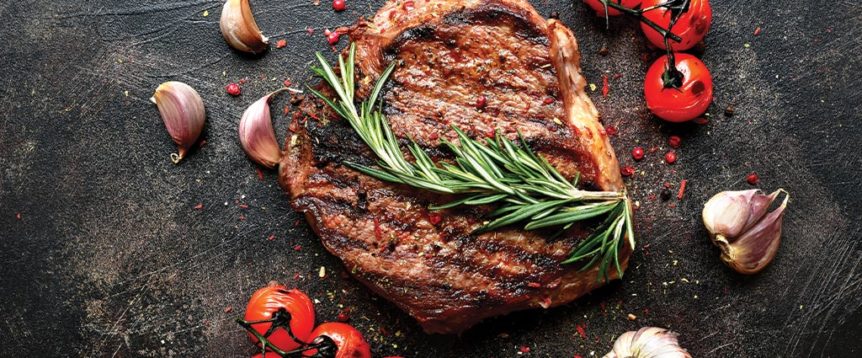We’ve been eating meat since we were cavemen. What does that tell us? You don’t have to be a Mensa scholar to cook a steak. Meat’s simplicity is part of its appeal, but choosing the right preparation and cooking method is what really makes each cut shine. There may not be a right or wrong way to prepare meat, but there are, arguably, good and better ways.
MARINATE
There are two reasons to marinate beef: to tenderize it and to flavor it. The more connective tissue a cut of meat has and the stronger/leaner its source muscle was during the animal’s life, the tougher it tends to be. (Tenderloin and filet are exceptions to this rule.) Heat is one way to break down the connective tissue, but some cuts need a running start. Enzymes from oils, fruit juices, wine, beer or spices can kickstart the process of breaking down the tissue. With the exception of tenderloin, top sirloins and bone-in cuts, most flat steaks that will be prepared over dry heat benefit from a liquid marinade. Place the meat and the liquid marinade in a zip-top plastic bag in the refrigerator for 30 minutes to several hours, flipping it regularly to ensure even coverage. Dry rubs are good for larger cuts such as briskets and roasts, but use salt sparingly as it will draw moisture out of the meat during cooking.
PAN-FRY
Thin and tender cuts such as flat iron and cubed steak cook in just a few minutes in the pan. Heat a little bit of oil in the skillet and season but don’t salt the cut before adding it to the pan. Adding salt too early will dry out your meat, so wait until it’s fully cooked before salting. Ground beef cooks quickly and cleanly in a nonstick skillet over medium heat, which explains why 43 percent of Americans prepare it at home twice a week or more.
SKILLET-TO-OVEN
Thick-cut boneless fillets like tenderloin are ideal for this method. Browning the fillets in a heavy, ovenproof, nonstick skillet for a couple minutes on each side before transferring the pan to the oven ensures the outsides and insides of the meat get cooked evenly.
BRAISE/POT ROAST
Braising or pot-roasting—cooking with moist heat—tenderizes meat and is ideal for large roasts and tough bone-in cuts from the chuck, loin and round. Another benefit: It’s relatively labor-light. After briefly pan-searing the meat in a heavy pan, you can place it in a large pot with flavorful liquid—beer, wine, broth or stock—and leave it alone while it cooks for an hour or more on the stove or in the oven.
BROIL
A common alternative to grilling and a good option when you can’t or don’t want to go outside to the grill, broiling uses direct heat to cook thin, tender steaks that stand up to this method without drying out. A few tricks: Always place your meat on a preheated broiler pan that allows the grease and fat to drip off, leave the oven door slightly open while cooking, use tongs or a spatula rather than a meat fork to flip the steak without losing any juices.
GRILL
Gas or charcoal grills are ideal, but a stove-top grill pan works too. And you wouldn’t be American if we had to tell you that everything from burger patties to flank steak to ribeyes are show stoppers when cooked this way.
INDIRECT GRILLING
Bet you thought grilling only worked for steaks and burgers, but that isn’t true. You can turn your charcoal or gas grill into an outdoor oven to cook larger cuts such as ribeye and sirloin roasts with this method. Marinate or season your meat as desired Fire up the barbecue like you normally would, but don’t place the meat directly over the flame. Instead set it to the side of the flame and close the lid. In 45 to 90 minutes, depending on the size of the roast, dinner will be ready, almost. Remove the roast from the grill when it’s about 10 or 15 degrees below your desired temperature (see right) and let it rest under an aluminum-foil tent for 10 to 15 minutes. Slice and enjoy.
OVEN ROAST
When making cookies with this method, it’s called baking. When preparing meat, it’s called oven-roasting. The heated air inside the enclosed oven circulates around the food to cook it evenly on all sides. Using a low-temperature allows you to slow-roast meat, so it’s ideal for preparing large cuts that need plenty of time to tenderize. A higher temperature speeds roasting time, so it is best for cuts of meat that are naturally tender.
Get Saucy

—Andrew Rimas, Beef: The Untold Story of How Milk, Mean, and Muscle Shaped the World (HarperCollins, 2009)
How Do You Like It?
Using a meat thermometer ensures you’ll always get the internal temperature just right, whether you like it bloody, slightly pink or twice dead.
Rare: 115–130º
Medium Rare: 130–135º
Medium: 135–140º
Medium Well: 140–150º
Well Done: 155–170º
Ground Beef: 160º
More about beef:
BEEF: Meat Your Match: How much and what’s the grade?
BEEF: What the Cut: The five major categories of cuts

